Physicochemical, Sensorial and Microbiological Characterization of PoroCheese, an Artisanal Mexican Cheese Made from Raw Milk †
Abstract
1. Introduction
2. Materials and Methods
2.1. Sampling
2.2. Physicochemical and Texture Analysis
2.3. Rheological Analysis
2.4. Color Measurement
2.5. Sensorial Analysis
2.6. Microbiological Enumeration
2.7. Strains Isolation and Biochemical Identification
2.8. DNA Extraction and PCR Amplification
2.9. Strains Identification and Time Temperature Gel Electrophoresis (TTGE)
2.10. Statistical Analysis
3. Results and Discussion
3.1. Physicochemical Analysis
3.2. Texture Profile Analysis
3.3. Rheological Analysis
3.4. Color Measurement
3.5. Sensorial Analysis
3.6. Microbiological Analysis
4. Conclusions
Author Contributions
Funding
Conflicts of Interest
References
- Villegas de Gante, A. TecnologiaQue sera. México Trillas 2004, 1, 1–398. [Google Scholar]
- Ramírez-Navas, J.S.; Rodríguez de Stouvenel, A. Characterization of Colombian Quesillo cheese by spectrocolorimetry. Vitae 2012, 19, 178–185. [Google Scholar]
- SIAP. Available online: http://infosiap.siap.gob.mx/ (accessed on 13 September 2019).
- Solis-Mendez, A.D.; Estrada-Flores, J.G.; Castelan-Ortega, O.A. A study on the texture diversity of the Artisan Ranchero Cheese from Central Mexico. Int. J. Dairy Technol. 2013, 66, 37–44. [Google Scholar] [CrossRef]
- Ercan, D.; Korel, F.; Yuceer, Y.K.; Kinik, O. Physicochemical, textural, volatile, and sensory profiles of traditional Sepet cheese. J. Dairy Sci. 2011, 94, 4300–4312. [Google Scholar] [CrossRef]
- Karagul-Yuceer, Y.; Isleten, M.; Uysal-Pala, C. Sensory characteristics of Ezine cheese. J. Sens. Stud. 2007, 22, 49–65. [Google Scholar] [CrossRef]
- Fresno, M.; Alvarez, S. Chemical, textural and sensorial changes during the ripening of Majorero goat cheese. Int. J. Dairy Technol. 2012, 65, 393–400. [Google Scholar] [CrossRef]
- Lopez, M.B.; Ferrandini, E.; Rodriguez, M.; Roca, J.D.; Haba, E.; Luna, A.; Rovira, S. Physicochemical study of Murcia al Vino cheese. Small Rumin. Res. 2012, 106, 154–159. [Google Scholar] [CrossRef]
- Hernandez-Morales, C.; Hernandez-Montes, A.; Aguirre-Mandujano, E.; De Gante, A.V. Physicochemical, microbiological, textural and sensory characterisation of Mexican Anejo cheese. Int. J. Dairy Technol. 2010, 63, 552–560. [Google Scholar] [CrossRef]
- Ariceaga, C.C.; Afzal, M.I.; Umer, M.; Shah, S.M.U.; Ahmed, H.; Jacquot, M.; Cailliez-Grimal, C. Effect of alginate beads on olfactory sensory perception of parraffin-coated cheese. Czech J. Food Sci. 2018, 36, 255–260. [Google Scholar] [CrossRef]
- Ramos Cordova, M. Manual de Métodos de Analisis de Leche y Lacticineos; Food and Agriculture Organization of the United Nations: Rome, Italy, 1976; p. 72. [Google Scholar]
- AOAC. Official Methods of Analysis, 15th ed.; Association of Analytical Chemists International: Washington, DC, USA, 1995. [Google Scholar]
- Lobato-Calleros, C.; Ramirez-Santiago, C.; Osorio-Santiago, V.J.; Vernon-Carter, E.J.; Hornelas-Uribe, Y. Microstructure and texture of Manchego cheese-like products made with canola oil, lipophilic and hydrophilic emulsifiers. J. Texture Stud. 2002, 33, 165–182. [Google Scholar] [CrossRef]
- Serhan, M.; Cailliez-Grimal, C.; Borges, F.; Revol-Junelles, A.M.; Hosri, C.; Fanni, J. Bacterial diversity of Darfiyeh, a Lebanese artisanal raw goat’s milk cheese. Food Microbiol. 2009, 26, 645–652. [Google Scholar] [CrossRef] [PubMed]
- Edima, H.C.; Cailliez-Grimal, C.; Revol-Junelles, A.M.; Tonti, L.; Linder, M.; Milliere, J.B. A selective enumeration medium for Carnobacteriummaltaromaticum. J. Microbiol. Methods 2007, 68, 516–521. [Google Scholar] [CrossRef] [PubMed]
- Shannon, A.L.; Attwood, G.; Hopcroft, D.H.; Christeller, J.T. Characterization of lactic acid bacteria in the larval midgut of the Keratinophagouslepidopteran, Hofmannophilapseudospretella. Lett. Appl. Microbiol. 2001, 32, 36–41. [Google Scholar] [CrossRef] [PubMed]
- Pisano, M.B.; Fadda, M.E.; Deplano, M.; Corda, A.; Cosentino, S. Microbiological and chemical characterization of Fiore Sardo, a traditional Sardinian cheese made from ewe’s milk. Int. J. Dairy Technol. 2006, 59, 171–179. [Google Scholar] [CrossRef]
- Vasek, O.M.; Leblanc, J.G.; Fusco, A.; De Giori, G.S. Chemical composition and microbial evaluation of Argentinean Corrientes cheese. Int. J. Dairy Technol. 2008, 61, 222–228. [Google Scholar] [CrossRef]
- Van Hekken, D.L.; Tunick, M.H.; Tomasula, P.M.; Corral, F.J.M.; Gardea, A.A. Mexican Queso Chihuahua: Rheology of fresh cheese. Int. J. Dairy Technol. 2007, 60, 5–12. [Google Scholar] [CrossRef]
- Ramirez-Rivera, E.D.J.; Juarez-Barrientos, J.M.; Rodriguez-Miranda, J.; Diaz-Rivera, P.; Ramon-Canul, L.G.; Herrera-Corredor, J.A.; Hernandez-Serrano, M.I.; Herman-Lara, E. Typification of a fresh goat cheese of Mexico by path models. Turk. J. Vet. Anim. Sci. 2017, 41, 213–220. [Google Scholar] [CrossRef]
- Subramanian, R.; Gunasekaran, S. Small amplitude oscillatory shear studies on Mozzarella cheese Part I. Region of linear viscoelasticity. J. Texture Stud. 1997, 28, 633–642. [Google Scholar] [CrossRef]
- Drake, M.A.; Gerard, P.D.; Truong, V.D.; Daubert, C.R. Relationship between instrumental and sensory measurements of cheese texture. Relatsh. Instrum. Sens. Meas. Cheese Texture 1999, 30, 451–476. [Google Scholar] [CrossRef]
- Vinas, M.A.G.; Ballesteros, C.; Martin-Alvarez, P.J.; Cabezas, L. Relationship between sensory and instrumental measurements of texture for artisanal and industrial Manchego cheeses. J. Sens. Stud. 2007, 22, 462–476. [Google Scholar] [CrossRef]
- Farahani, G.; Ezzatpanah, H.; Abbasi, S. Characterization of Siahmazgi cheese, an Iranian ewe’s milk variety: Assessment of physico-chemical, textural and rheological specifications during ripening. LWT-Food Sci. Technol. 2014, 58, 335–342. [Google Scholar] [CrossRef]
- Juan, B.; Trujillo, A.J.; Guamis, V.; Buffa, M.; Ferragut, V. Rheological, textural and sensory characteristics of high-pressure treated semi-hard ewes’ milk cheese. Int. Dairy J. 2007, 17, 248–254. [Google Scholar] [CrossRef]
- Kahyaoglu, T.; Kaya, S. Effects of heat treatment and fat reduction on the rheological and functional properties of Gaziantep cheese. Int. Dairy J. 2003, 13, 867–875. [Google Scholar] [CrossRef]
- Diezhandino, I.; Fernandez, D.; Sacristan, N.; Combarros-Fuertes, P.; Prieto, B.; Fresno, J.M. Rheological, textural, colour and sensory characteristics of a Spanish blue cheese (Valdeon cheese). LWT-Food Sci. Technol. 2016, 65, 1118–1125. [Google Scholar] [CrossRef]
- Subramanian, R.; Muthukumarappan, K.; Gunasekaran, S. Linear viscoelastic properties of regular- and reduced-fat pasteurized process cheese during heating and cooling. Int. J. Food Prop. 2006, 9, 377–393. [Google Scholar] [CrossRef]
- Ustunol, Z.; Kawachi, K.; Steffe, J. Rheological properties of cheddar cheese as influenced by fat reduction and ripening lime. J. Dairy Sci. 1995, 60, 1208–1210. [Google Scholar]
- Tunick, M.H. Rheology of dairy foods that gel, stretch, and fracture. J. Dairy Sci. 2000, 83, 1892–1898. [Google Scholar] [CrossRef]
- Brown, J.A.; Foegeding, E.A.; Daubert, C.R.; Drake, M.A.; Gumpertz, M. Relationships among rheological and sensorial properties of young cheeses. J. Dairy Sci. 2003, 86, 3054–3067. [Google Scholar] [CrossRef]
- Muliawan, E.B.; Hatzikiriakos, S.G. Rheology of mozzarella cheese. Int. Dairy J. 2007, 17, 1063–1072. [Google Scholar] [CrossRef]
- Henno, M.; Joudu, I.; Kaart, T.; Veskioja, A.; Ots, M. Changes in rheological properties of Edam-type cheese during ripening. Agric. Food Sci. 2017, 26, 198–206. [Google Scholar]
- Verdier-Metz, I.; Coulon, J.B.; Pradel, P.; Viallon, C.; Albouy, H.; Berdague, J.L. Effect of the botanical composition of hay and casein genetic variants on the chemical and sensory characteristics of ripened Saint-Nectaire type cheeses. LeLait 2000, 80, 361–370. [Google Scholar] [CrossRef]
- Brighenti, M.; Govindasamy-Lucey, S.; Lim, K.; Nelson, K.; Lucey, J.A. Characterization of the rheological, textural, and sensory properties of samples of commercial US cream cheese with different fat contents. J. Dairy Sci. 2008, 91, 4501–4517. [Google Scholar] [CrossRef] [PubMed]
- Afzal, M.I.; Ariceaga, C.C.; Lhomme, E.; Ali, N.K.; Payot, S.; Burgain, J.; Gaiani, C.; Borges, F.; Revol-Junelles, A.M.; Delaunay, S.; et al. Characterization of Carnobacteriummaltaromaticum LMA 28 for its positive technological role in soft cheese making. Food Microbiol. 2013, 36, 223–230. [Google Scholar] [CrossRef] [PubMed]
- Afzal, M.I.; Boulahya, K.A.; Paris, C.; Delaunay, S.; Cailliez-Grimal, C. Effect of oxygen on the biosynthesis of flavor compound 3-methylbutanal from leucine catabolism during batch culture in Carnobacteriummaltaromaticum LMA 28. J. Dairy Sci. 2013, 96, 352–359. [Google Scholar] [CrossRef]
- Afzal, M.I.; Delaunay, S.; Paris, C.; Borges, F.; Revol-Junelles, A.M.; Cailliez-Grimal, C. Identification of metabolic pathways involved in the biosynthesis of flavor compound 3-methylbutanal from leucine catabolism by Carnobacteriummaltaromaticum LMA 28. Int. J. Food Microbiol. 2012, 157, 332–339. [Google Scholar] [CrossRef]
- Afzal, M.I.; Jacquet, T.; Delaunay, S.; Borges, F.; Milliere, J.B.; Revol-Junelles, A.M.; Cailliez-Grimal, C. Carnobacteriummaltaromaticum: Identification, isolation tools, ecology and technological aspects in dairy products. Food Microbiol. 2010, 27, 573–579. [Google Scholar] [CrossRef]
- Miller, A.; Morgan, M.E.; Libbey, L.M. Lactobacillus maltaromicus, a new species producing a malty aroma. Int. J. Syst. Bacteriol. 1974, 24, 346–354. [Google Scholar] [CrossRef]
- Ward, D.E.; Ross, R.P.; van der Weijden, C.C.; Snoep, J.L.; Claiborne, A. Catabolism of branched-chain alpha-keto acids in Enterococcus faecalis: The bkd gene cluster, enzymes, and metabolic route. J. Bacteriol. 1999, 181, 5433–5442. [Google Scholar]
- Smit, G.; Smit, B.A.; Engels, W.J.M. Flavour formation by lactic acid bacteria and biochemical flavour profiling of cheese products. FEMS Microbiol. Rev. 2005, 29, 591–610. [Google Scholar] [CrossRef]
- Afzal, M.I.; Ariceaga, C.C.G.; Boulahya, K.A.; Jacquot, M.; Delaunay, S.; Cailliez-Grimal, C. Biosynthesis and role of 3-methylbutanal in cheese by lactic acid bacteria: Major metabolic pathways, enzymes involved, and strategies for control. Crit. Rev. Food Sci. Nutr. 2017, 57, 399–406. [Google Scholar] [CrossRef]
- Navidghasemizad, S.; Hesari, J.; Saris, P.; Nahaei, M.R. Isolation of lactic acid bacteria from Lighvan cheese, a semihard cheese made from raw sheep milk in Iran. Int. J. Dairy Technol. 2009, 62, 260–264. [Google Scholar] [CrossRef]
- Veljovic, K.; Terzic-Vidojevic, A.; Vukasinovic, M.; Strahinic, I.; Begovic, J.; Lozo, J.; Ostojic, M.; Topisirovic, L. Preliminary characterization of lactic acid bacteria isolated from Zlatar cheese. J. Appl. Microbiol. 2007, 103, 2142–2152. [Google Scholar] [CrossRef] [PubMed]
- Renye, J.A.; Somkuti, G.A.; Van Hekken, D.L.; Prieto, V.M.G. Short communication: Characterization of microflora in Mexican Chihuahua cheese. J. Dairy Sci. 2011, 94, 3311–3315. [Google Scholar] [CrossRef] [PubMed]
- Morales, F.; Morales, J.I.; Hernandez, C.H.; Hernandez-Sanchez, H. Isolation and Partial Characterization of Halotolerant Lactic Acid Bacteria from Two Mexican Cheeses. Appl. Biochem. Biotechnol. 2011, 164, 889–905. [Google Scholar] [CrossRef] [PubMed]
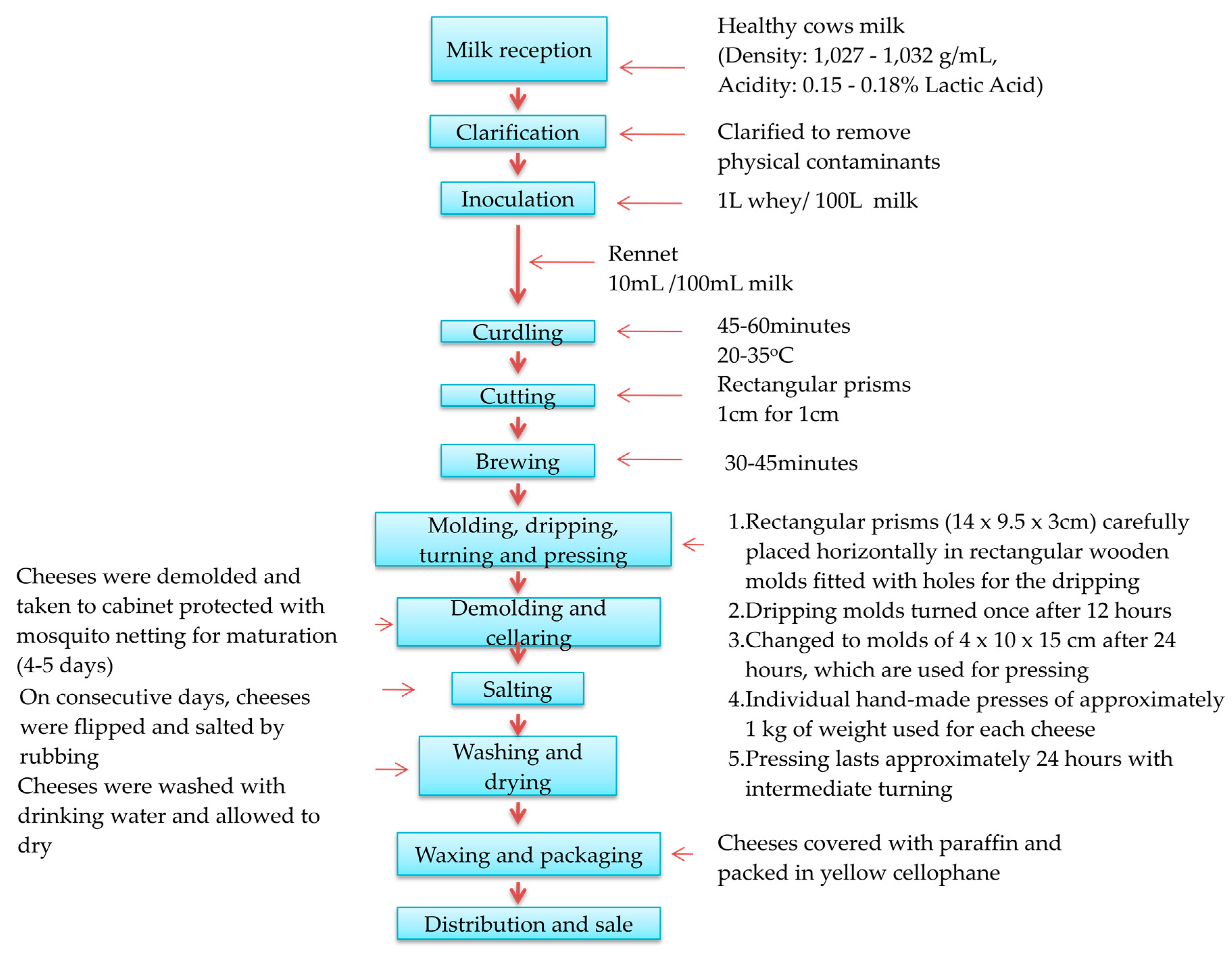
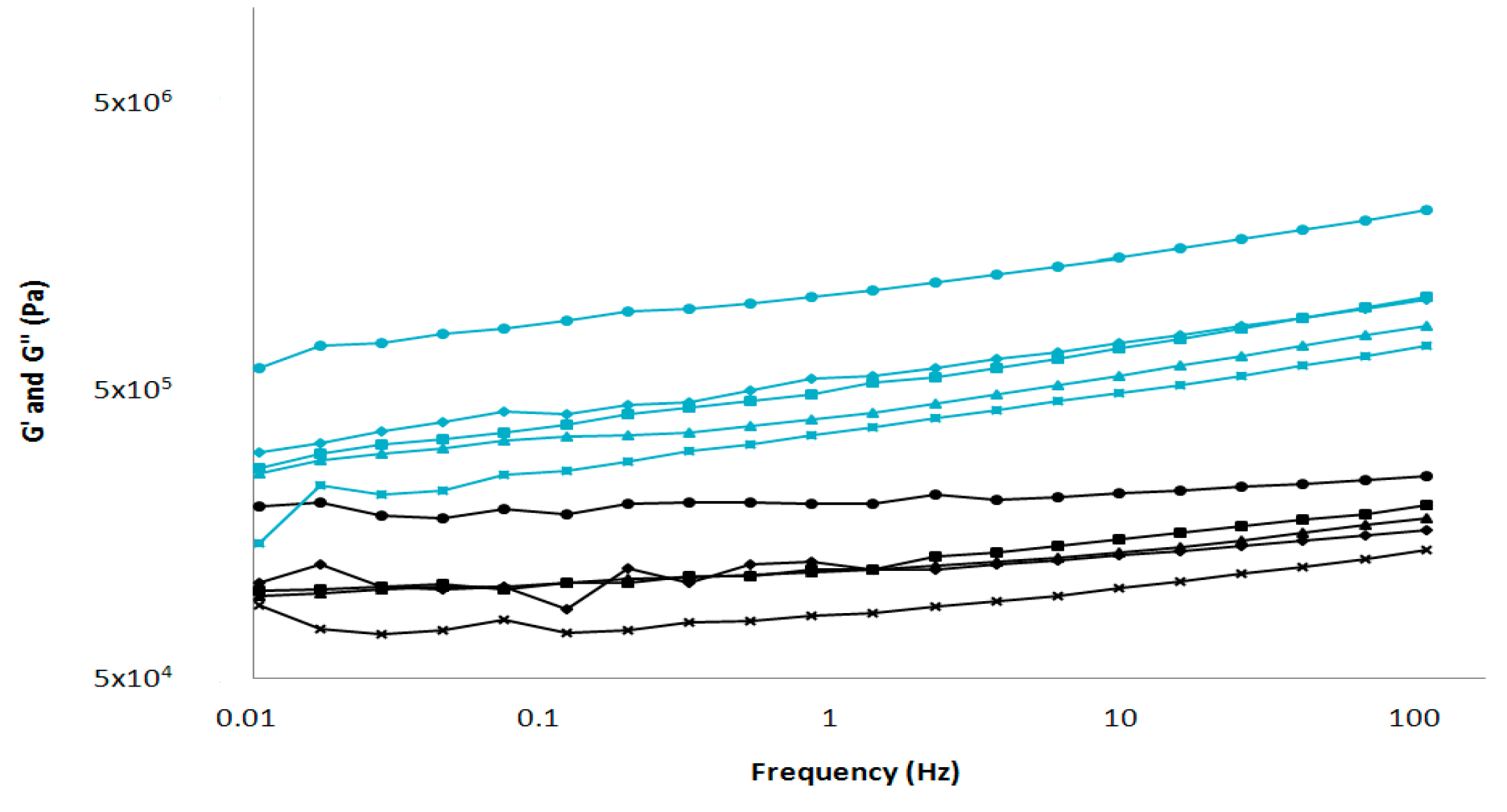
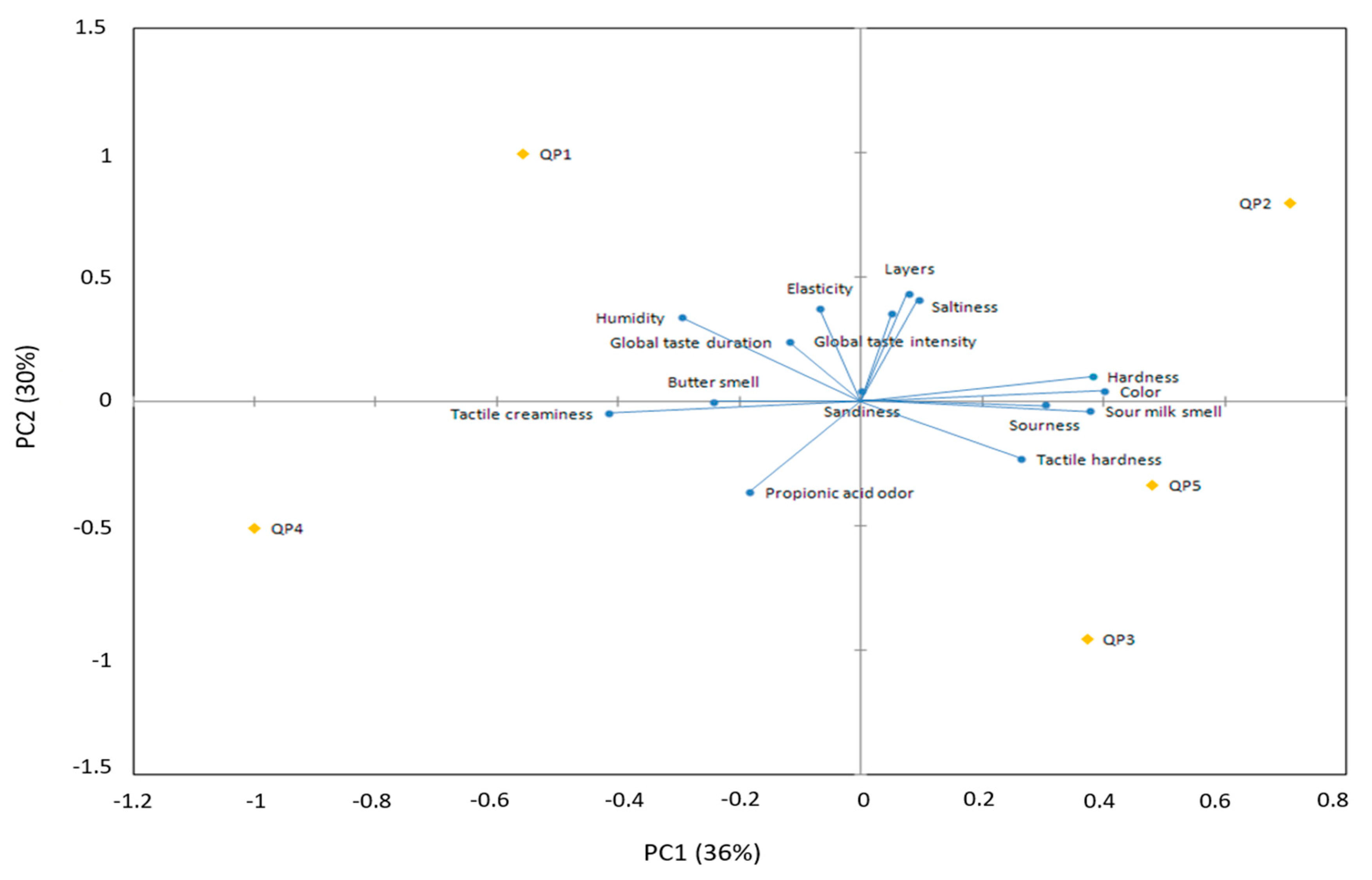
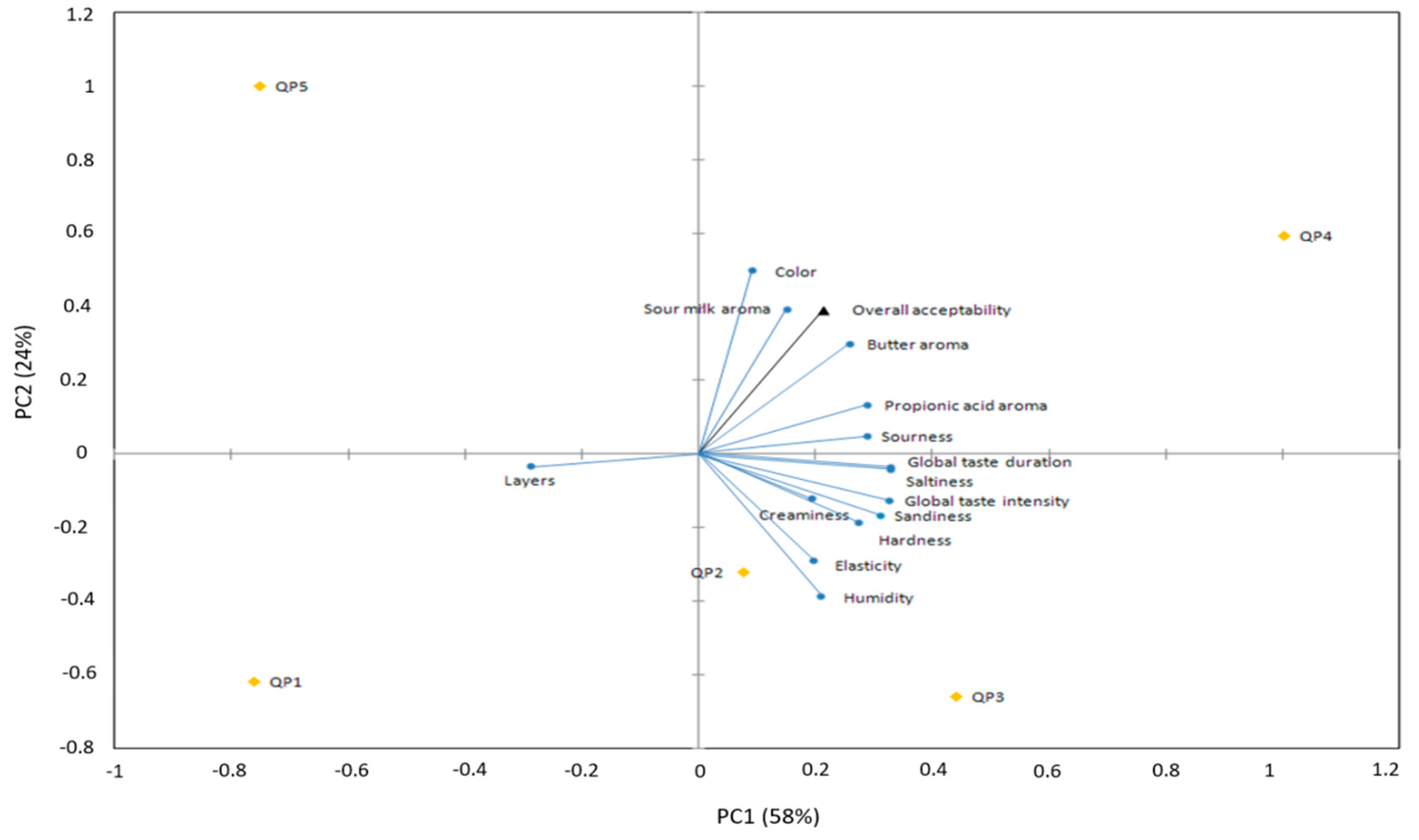
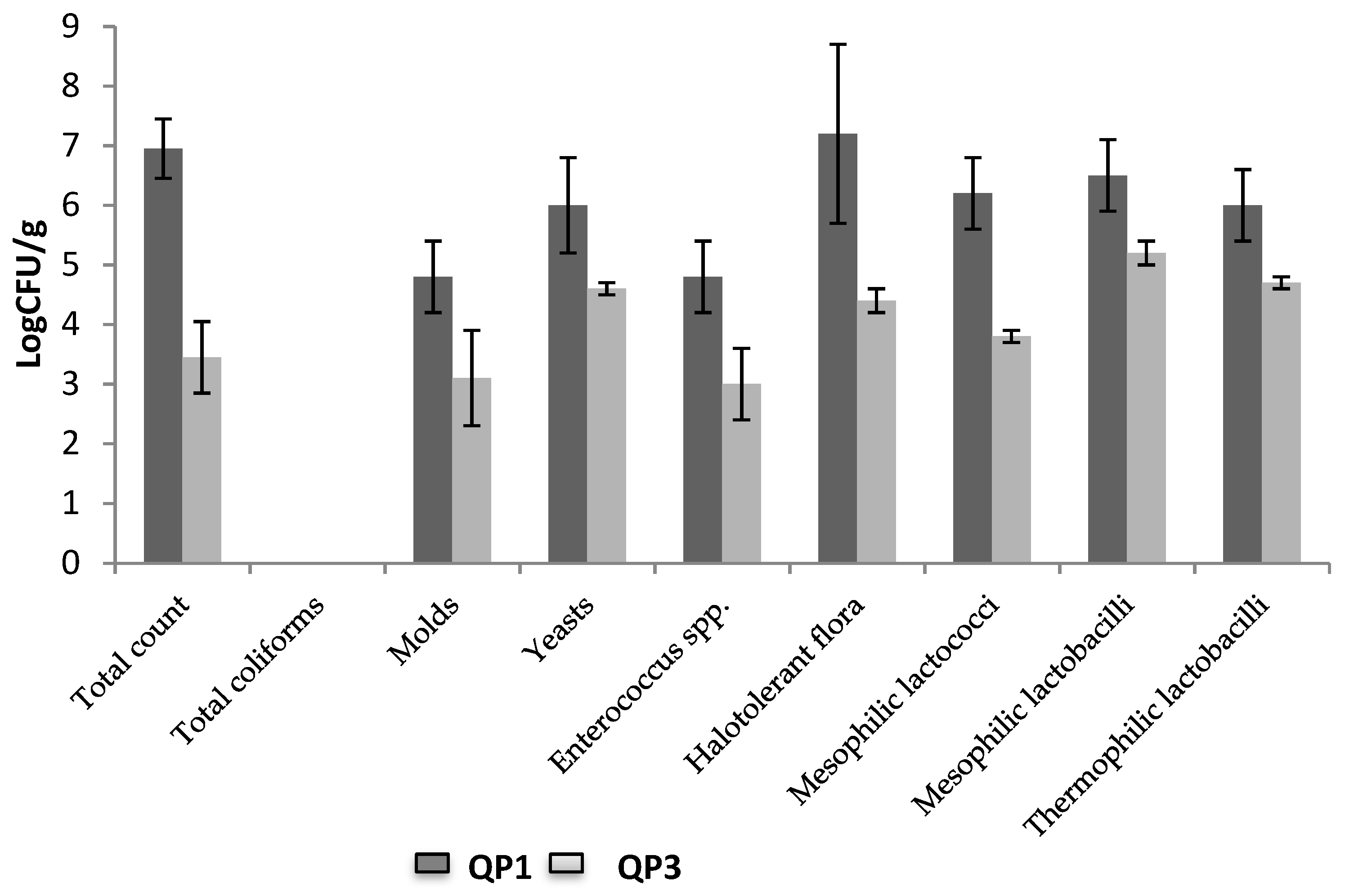
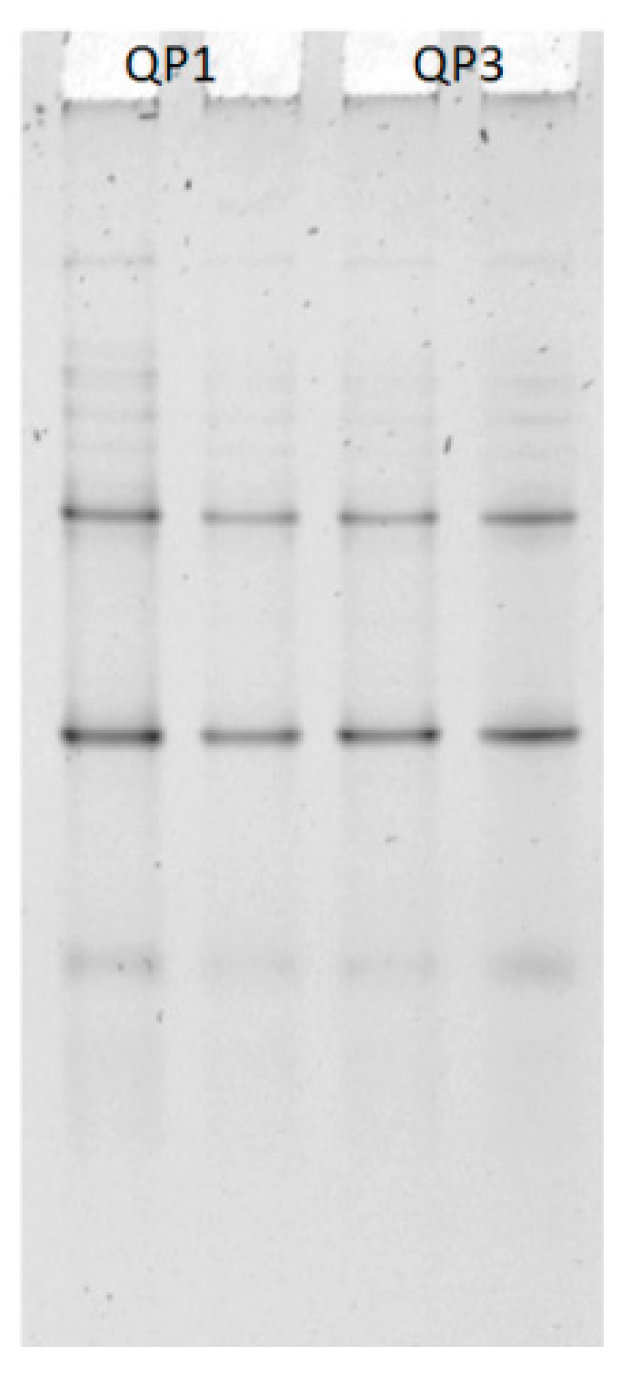
| Descriptor | Definition | Reference and Intensity |
|---|---|---|
| Color | Color from white to yellow | White adhesive paper (Janel) YI (−19.18), I = 1.5 Yellow adhesive paper (Post-it) YI (53.63), I = 11 |
| Layers resolution | Space resolution due to the layers arrangement during cheese pressing | Craker Habanera (Gamesa), I = 5 Banderilla puff pastry (El globo), I = 11.5 |
| Sour milk aroma | Aromas associated with the fermented sour milk | Lactic acid, 0.05% in milk, I = 4.5 Lactic acid, 1% in milk, I = 9 |
| Butter aroma | Aromas associated with the butter | Diacetyl, 5 drops in 100 mL of milk, I = 4 Diacetyl, 10 drops in 100 mL of milk, I = 9 |
| Propionic acid aroma | Strong, irritating smell associated with mature cheese | Propionic acid 5 drops in 100 mL of milk, I = 5 Propionic acid 15 drops in 100 mL of milk, I = 10 |
| Tactile hardness | Force required to compress a sample piece between the fingers | Cocktail sausage (Swan), I = 4.5 Cut into cubes of 6 mm by 6 mm raw carrot, I = 13 |
| Tactile creaminess | Sensation associated with the fat present in the sample at the time of touching | Cotija cheese (Esmeralda, Distribuidora de LácteosAlgil), I = 4 Philadelphia Cheese (Kraft Foods Inc.), I = 13 |
| Sandiness | Sensation associated with small particles of sand | Panela cheese (LALA), I = 5 Parmesan cheese (Kraft Foods Inc.), I = 12 |
| Elasticity | Sample capacity to recover its original shape when compressed with the molars | Cotija cheese (Esmeralda, Distribuidora de LácteosAlgil), I = 4 Panela cheese (LALA), I = 10 |
| Humidity | Amount of water perceived in the oral cavity | Cotija cheese (Esmeralda, Distribuidora de LácteosAlgil), I = 4 Panela cheese (LALA), I = 11 |
| Hardness | Force required to penetrate the simple with molars | Cocktail sausage (Swan), I = 3 Cut into cubes of 6 mm by 6 mm raw carrot, I = 11 |
| Saltiness | Basic taste sensation occasioned by salts | Sodium chloride, 0.35% in water, I = 6 Sodium chloride, 0.5% in water, I = 11 |
| Sourness | Basic taste sensation occasioned by acids | Citric acid, 0.2% in water, I = 5 Citric acid, 0.5% in water, I = 11 |
| Global taste intensity | Force of cheese flavor | Cotija cheese (Esmeralda, Distribuidora de LácteosAlgil), I = 12.5 |
| Global taste duration | Duration of cheese flavor | Cotija cheese (Esmeralda, Distribuidora de LácteosAlgil), I = 12 |
| Group Targeted | Medium | Incubation Temperature (°C) | Incubation Time | Anaerobic or Aerobic Conditions |
|---|---|---|---|---|
| Total count | PCA | 30 | 72 h | A |
| Total coliforms | VRBA | 30 | 24 h | A |
| Molds | OGA | 25 | 5 days | A |
| Yeasts | OGA | 25 | 5 days | A |
| Enterococcus spp. | BEA | 37 | 48 h | A |
| Halotolerant flora | BHI + 5% NaCl | 25 | 48 h | A |
| Lactococcus mesophilic | M17 | 25 | 48 h | A |
| Lactobacillus mesophilic | MRS pH 5.7 | 25 | 48 h | An |
| Lactobacillus thermophilic | MRS pH 5.7 | 42 | 48 h | An |
| Factory Code | Chemical Composition | Mean Texture Profile Analyses (TPA) | Rheological Characteristic | Color Measurement | ||||||||||||||
|---|---|---|---|---|---|---|---|---|---|---|---|---|---|---|---|---|---|---|
| Fat (%) | Moisture (%) | Protein (%) | NaCl (%) | Ca2+ (%) | pH | aw | Hardness (N) | Adhesiveness (Ns) | Cohesiveness | Springiness | Chewiness (N) | Storage module G’ (kPa) | Loss modules G” (kPa) | Luminosity | YI | Chrome | Hue * | |
| QP1 | 29.8 A | 34.8 A | 24.5 A | 3.9 A | 0.28 A | 4.9 A | 0.947 A,B | 11.92 A | −0.000 A | 0.42 A | 0.83 A | 4.08 A | 510.69 A | 110.62 A | 86.33 A | 32.42 A | 17.37 A | 90.08 A |
| QP2 | 31.3 B | 31.5 B | 39.4 B | 2.3 B,C | 0.12 B | 4.3 B | 0.953 A | 14.89 A,D | −0.313 B | 0.40 A | 0.63 B | 3.77 A | 424.15 A | 117.70 A | 87.49 A,B | 36.02 B | 19.70 BC | 89.59 A |
| QP3 | 37.0 C | 28.1 B | 26.3 C | 2.5 B,C | 0.19 A,B | 4.6 C | 0.930 B | 29.63 B | −0.176 C | 0.38 A | 0.80 A | 9.01 B | 1081.14 B | 177.92 B | 89.06 B | 37.92 B | 21.27 B | 89.46 A,B |
| QP4 | 31.2 B | 33.6 A | 27.4 B,C | 2.0 C | 0.12 B | 4.7 A,C | 0.954 A | 23.86 C | −0.001 A | 0.47 A | 0.89 A | 9.97 B | 281.91 C | 67.40 C | 89.41 B | 40.00 B,C | 22.53 B | 88.91 B |
| QP5 | 30.6 A,B | 37.0 A,C | 26.8 C | 2. 7 B | 0.15 B | 4.4 B,C | 0.955 A | 16.63 D | −0.643 D | 0.41 A | 0.74 A,B | 5.10 A | 487.05 A | 117.80 A | 90.01 B | 31.89 D | 36.3 D | 61.45 C |
| Descriptor | Cheeses Factory Code | ||||
|---|---|---|---|---|---|
| QP1 | QP2 | QP3 | QP4 | QP5 | |
| Color | 6.73 A | 7.42 A | 7.4 A | 6.01 B | 7.04 A |
| Layers resolution | 7.34 A | 7.12 A | 5.49 B | 5.79 B | 6.79 A |
| Sour milk aroma | 7.71 A | 8.07 A | 7.92 A | 7.80 A | 7.97 A |
| Butter aroma | 7.19 A | 6.85 A | 7.17 A | 7.06 A | 6.66 A |
| Propionic acid aroma | 7.81 A | 7.75 A | 8.21 A | 8.20 A | 7.77 A |
| Tactile hardness | 9.93 B,C | 9.92 B,C | 10.94 A | 9.52 C | 10.33 A,B |
| Tactile creaminess | 6.39 A,B | 5.34 C,D | 5.64 D | 6.85 A | 5.91 B,C |
| Sandiness | 7.50 A | 6.79 A | 7.13 A | 6.86 A | 7.51 A |
| Elasticity | 5.61 A | 5.60 A | 5.25 A | 5.51 A | 5.56 A |
| Humidity | 4.71 A | 4.27 A,B | 3.73 C | 4.46 A | 3.92 B,C |
| Hardness | 6.84 A,B | 7.11 A | 6.96 A | 6.12 B | 7.27 A |
| Saltiness | 7.76 A | 7.77 A | 7.37 A | 7.14 A | 7.18 A |
| Sourness | 7.45 C | 8.39 A | 7.98 A,B | 7.75 B,C | 7.79 B,C |
| Global taste intensity | 9.62 A | 9.65 A | 9.20 A,B | 8.88 B,C | 8.68 C |
| Global taste duration | 9.02 A | 8.88 A | 8.72 A | 8.62 A | 7.9 B |
| Poro Cheese | Other Mexican Cheeses | |||||
|---|---|---|---|---|---|---|
| Accession No. | % Identity | Closed Relative | LAB Population % | Chihuahua A | Doble Crema B | Cotija B |
| HQ449670.1 | 99 | Lactobacillus fermentum | 15 | + | ||
| AB300210.1 | 100 | Lactobacillus plantarum | 52 | + | + | |
| AB289102.1 | 99 | Lactobacillus farciminis | 11 | + | ||
| JN415185.1 | 100 | Lactobacillus rhamnosus | 11 | + | + | |
| FR871760.1 | 99 | Lactobacillus pentosus | 4 | + | + | |
| AB548882.1 | 99 | Lactobacillus brevis | 4 | |||
| GU122150.1 | 100 | Enterococcus faecium | 4 | + | + | |
© 2019 by the authors. Licensee MDPI, Basel, Switzerland. This article is an open access article distributed under the terms and conditions of the Creative Commons Attribution (CC BY) license (http://creativecommons.org/licenses/by/4.0/).
Share and Cite
González Ariceaga, C.C.; Afzal, M.I.; Umer, M.; Abbas, S.; Ahmad, H.; Sajjad, M.; Parvaiz, F.; Imdad, K.; Imran, M.; Maan, A.A.; et al. Physicochemical, Sensorial and Microbiological Characterization of PoroCheese, an Artisanal Mexican Cheese Made from Raw Milk. Foods 2019, 8, 509. https://doi.org/10.3390/foods8100509
González Ariceaga CC, Afzal MI, Umer M, Abbas S, Ahmad H, Sajjad M, Parvaiz F, Imdad K, Imran M, Maan AA, et al. Physicochemical, Sensorial and Microbiological Characterization of PoroCheese, an Artisanal Mexican Cheese Made from Raw Milk. Foods. 2019; 8(10):509. https://doi.org/10.3390/foods8100509
Chicago/Turabian StyleGonzález Ariceaga, Citlalli Celeste, Muhammad Inam Afzal, Muhammad Umer, Shabbar Abbas, Haroon Ahmad, Muhammad Sajjad, Fahed Parvaiz, Kaleem Imdad, Muhammad Imran, Abid Aslam Maan, and et al. 2019. "Physicochemical, Sensorial and Microbiological Characterization of PoroCheese, an Artisanal Mexican Cheese Made from Raw Milk" Foods 8, no. 10: 509. https://doi.org/10.3390/foods8100509
APA StyleGonzález Ariceaga, C. C., Afzal, M. I., Umer, M., Abbas, S., Ahmad, H., Sajjad, M., Parvaiz, F., Imdad, K., Imran, M., Maan, A. A., Khan, M. K. I., Ullah, A., Hernández-Montes, A., Aguirre-Mandujano, E., Villegas de Gante, A., Jacquot, M., & Cailliez-Grimal, C. (2019). Physicochemical, Sensorial and Microbiological Characterization of PoroCheese, an Artisanal Mexican Cheese Made from Raw Milk. Foods, 8(10), 509. https://doi.org/10.3390/foods8100509






